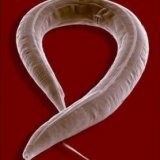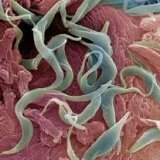Fasciolosis symptoms of the cause
 Fascioliasis in cities is not a frequent disease. But a person can get sick of them because of poorly cooked meat. Therefore, you need to be careful when preparing food in general. This article describes the symptoms and causes that accompany fascioliasis.
Fascioliasis in cities is not a frequent disease. But a person can get sick of them because of poorly cooked meat. Therefore, you need to be careful when preparing food in general. This article describes the symptoms and causes that accompany fascioliasis.
Fascioliasis: symptoms, causes.
Fascioliasis is a rare infectious disease caused by parasites. These parasites are called hepatic trematodes, they live in herbivores. Hepatic flukes can be found on aquatic plants in some parts of the world. When parasites enter the liver, the bile ducts can be blocked. Fascioliasis affects the throat( pharynx).This infection can be controlled and / or cured with timely treatment.
Symptoms of fascioliasis.
The disease has three phases: acute, latent and chronic. The acute phase begins about four days after infection and can last from two to four months. Symptoms during this phase include fever, abdominal pain in the stomach, gastrointestinal upset and rash( urticaria) accompanied by asthma attacks. The latent phase begins when mature flukes reach the bile ducts and can last for several months. People in this phase have asymptomatic illness. The chronic phase may persist for several years. Symptoms include gastrointestinal pain, food intolerance, nausea, jaundice, pruritus.
Causes of fascioliasis.
The cause of fascioliasis is an infection with parasitic worms of the genus Fasciola, of which fasciola vulgaris, found in temperate climates, and fasciola gigantic, found in tropical climates, they are the most common. The incestuous parasitic larvae of these parasites live on aquatic plants, such as watercress, which can be eaten by both humans and animals. These plants are eaten by man. After swallowing, the larvae pass from the cyst to the small intestine and migrate through the intestinal wall into the abdominal cavity. They turn into immature worms and, as soon as they reach the liver, begin to grow up to six weeks, feeding on liver tissue. Eventually, they settle in the bile ducts, where they cause lesions and chronic liver diseases. As a rule, a parasite can be killed while cooking, before they are eaten.
Risk groups.
Fasciolus is more common in communities where cattle, goats and sheep are common. Parasites can be transmitted to humans through meat that is poorly cooked or poorly processed. This disease is more common in the East and the tropics. It is estimated that 2, 4 million people are infected worldwide. Infection is present in domestic animals in almost all countries where cattle. The disease affects representatives of both sexes and all ages.
Other infectious diseases caused by parasites can be connected by roundworms, tapeworms, protozoans, flukes and other bacteria. Fascioliasis affects the throat. This is due to the fact that there are fasciolae vulgaris and fasciola giant or other parasites.
Diagnosis of fasciola.
Diagnosis of liver disease should be checked if the patient has recently spent time in a region where the infection is common in animals or people. Patients usually complain after drinking wild watercress, algae or other aquatic plants. Acute and chronic infections can be confirmed by testing, which detects hepatic duodenum-specific antibodies in biological fluids. In addition, eggs of the parasite can be found in the stool in the chronic stage of infection. Rapid treatment of fascioliasis is necessary to prevent complications of the liver caused by this disease. Diseases of the liver are well treated with drugs, for example, triclabendazole. This drug is administered after meals and, as a rule, in a single dose. In severe cases, two doses are used at intervals of 12 hours. It is effective against adults and immature worms. Some drugs have been used previously, such as bithionol, it should have been administered orally for five days, and another drug, praziquantel, which is effective against some similar parasitic organisms, but is not effective against the fasciolae species. Most importantly, all meat should be well cooked before it is eaten by a person.


